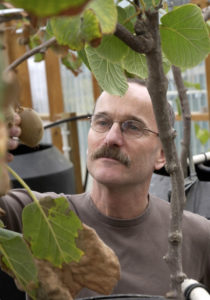I was delighted to learn that Dr Brent Clothier, FRSNZ, a Principal Scientist at Plant & Food Research, will be the next President of the Royal Society Te Aparangi. Elected to succeed Professor Wendy Larner, FRSNZ, he will serve as President-elect through to July 2021, when his three-year term commences.
 Dr Clothier is the first Crown Research Institute scientist to lead the 153-year old society (previously known as the Royal Society of New Zealand) since the CRIs were formed in 1992. Two presidents came from government research organisations which preceded the CRIs before 1992.
Dr Clothier is the first Crown Research Institute scientist to lead the 153-year old society (previously known as the Royal Society of New Zealand) since the CRIs were formed in 1992. Two presidents came from government research organisations which preceded the CRIs before 1992.
Dr Clothier was elected a Fellow of the Royal Society of New Zealand in 1994, recognising him as one of the country’s outstanding researchers, and he has served in significant governance roles in New Zealand’s research system including the Marsden Council, Rutherford Foundation Trust and the Royal Society Council.
He has an international reputation in the soil and water sciences and recently became the first New Zealander to be elected to the Chinese Academy of Engineering. He holds adjunct professorships in New Zealand, Australia, and Spain and is an elected member of the Soil Science Society of America, the American Agronomy Society, and the American Geophysical Union. He was president of the New Zealand Society of Soil Science in 2009-10.
Based in Palmerston North, he has published over 300 scientific papers on soil science, water management, sustainable vineyard and orchard practices. He has contributed to environmental policy and areas such as valuation of ecosystem services and investment into ecological infrastructure.
Future of the CRIs
 I recall Megan Woods –Minister of Almost Everything nowadays, including research, science and innovation – telling our pre-election political forum in 2017 that merging the crown research institutes was a possibility. It looks like things are happening to provide a foundation for such a restructuring.
I recall Megan Woods –Minister of Almost Everything nowadays, including research, science and innovation – telling our pre-election political forum in 2017 that merging the crown research institutes was a possibility. It looks like things are happening to provide a foundation for such a restructuring.
The Ministry of Business, Innovation and Employment this month released a review of the New Zealand’s CRIs, the Te Pae Kahurangi Report, which it commissioned last year to present an independent view of the role the CRIs) can and should play in meeting the country’s scientific research needs. It details a range of findings and recommendations that will inform the ministry’s post-election advice for the incoming government.
A key conclusion of the review panel is that the CRIs remain a critical component of New Zealand’s science system but aspects of the system are not working well and the future will require an approach that is “more integrated”. I was by no means surprised by this and I’m sure my reaction would be shared by most if not all NZIAHS members.
I was especially encouraged to learn that funding and the competition generated by the funding system are among the issues calling for change. The review focused on CRIs but the report says many of the issues identified by stakeholders and discussed in the report apply to the wider science system.
The report says: “To the extent practicable, the scope of any changes that follow this review would usefully apply to the wider system, wherever relevant.”
Some aspects of public funding can incentivise unproductive competition and distort choices on ways to achieve impact from new knowledge, it says.
The report advises the ministry to review funding settings with the following objectives:
- Explicit and stable funding of fit-for-purpose core and high-priority research and science service capabilities and functions, including prioritised databases and collections (as determined at a pan-CRI level), as well as emergency response;
- A rebalancing of CRI public funding between stable and contestable funding, in favour of the former, reducing uncertainty and transaction costs, and enabling better medium-term planning;
- A planned approach to relevant elements of the funding system to enable a programme of research that is more integrated, focusing on the main crosscutting challenges such as climate change;
- A combination of organisational and funding arrangements that provide an appropriate level of financial stability.
MBIE The final report can be viewed at Te Pae Kahurangi Report 2020.
The NZIAHS has been asking for some time for a rebalancing of CRI public funding as outlined in the report. I would add to the recommendations that the rebalancing should aim to enable our best and brightest scientists to tackle challenges unimpeded.
Equally, many of us have identified the problem of public funding sometimes incentivising unproductive competition, including the perverse inter-CRI, and CRI vs private sector competition. In a general sense I would like to see:
- A robust public indicator or indicators of how much of the taxpayers’ science investment ends up producing “public good” outcomes; and
- A check on how much of it is consumed in bureaucracy before it ends up in the hands of researchers at the cutting edge of desperately needed research.
These are not quite the same things, the difference being that – as scientists in the NZIAHS – we need to know that our CRI colleagues are receiving adequate funding to indulge their creativity and skills, and to maximum public advantage/benefit if the taxpayers hard-earned is being offered up in funding.
Jon Hickford
President
NZIAHS












